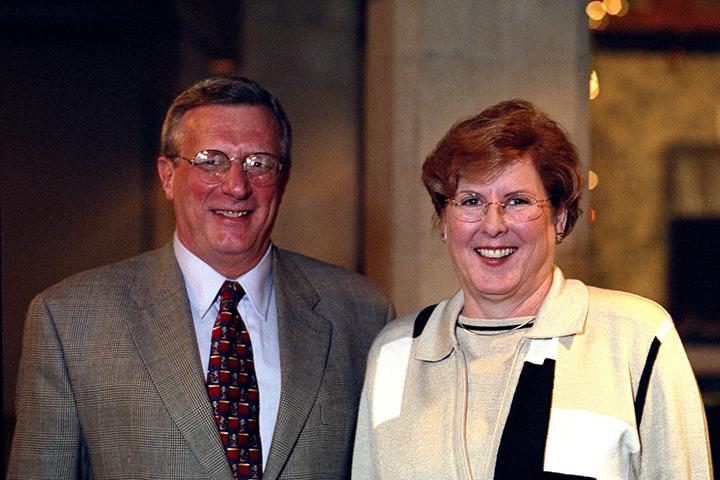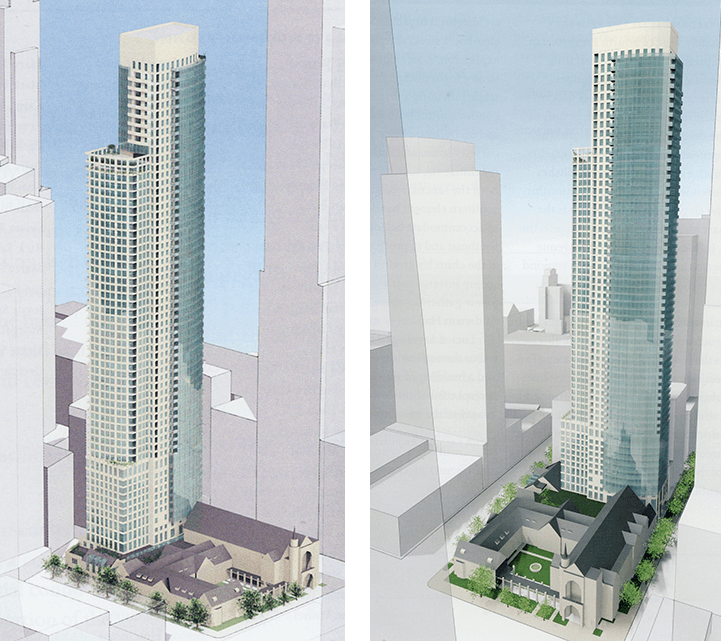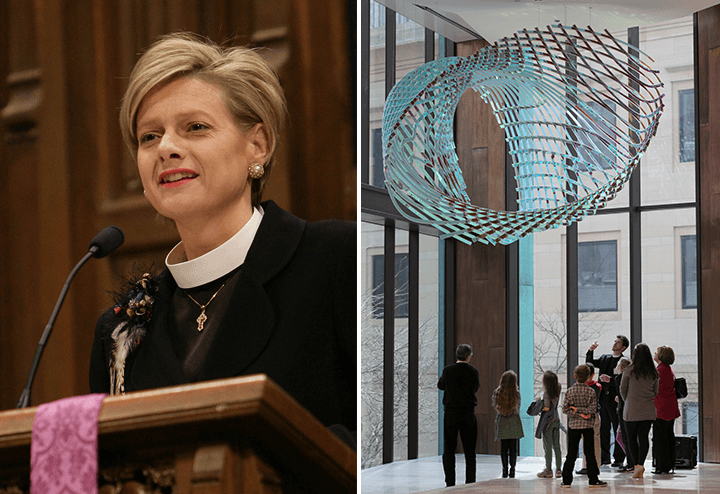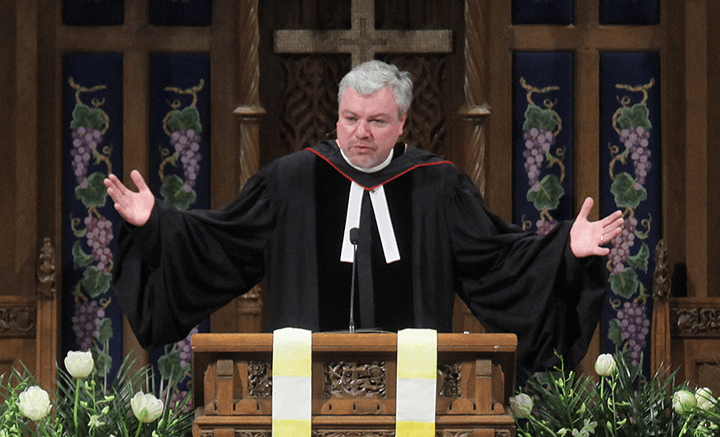“What we dare to believe is that God is Lord of the future—that God calls us into the future in courage and hope.”
—John Buchanan, September 23, 2001
As Fourth Church entered a new millennium, the congregation’s future looked quite bright. A third Sunday morning service had been added at 8:00 a.m., attendance and membership had continued to grow at a steady rate—particularly among young families, who were increasingly choosing to live in the city rather than move to the suburbs—and the church had assembled a large and dynamic team of associate pastors to complement Buchanan’s leadership. Despite these clear reasons for optimism, though, the next handful of years would test the resolve and resilience of the congregation as it navigated a series of setbacks, losses, and tragedies, with none greater than the horrific and tragic events of September 11, 2001.
Meeting just two hours after the initial terrorist attack on the Twin Towers, staff debated closing the church’s doors due to its proximity to the Hancock Center and fear of similar attacks occurring in Chicago. The decision, though, was soon unanimously made to remain open for prayer, and members of the pastoral staff sat and prayed with visitors to the Sanctuary throughout the day. Buchanan would also reach out to Father Robert McLaughlin of Holy Name Cathedral and Rabbi Michael Sternfield of Chicago Sinai Congregation, and a few days later, the three congregations held an interfaith service in the Sanctuary to a standing-room-only crowd as people processed, lamented, and grieved. Buchanan would later reflect that Fourth Church “rose to meet the moment” that week, and that would certainly be the case in the weeks and months that followed, as Buchanan spoke out against the war in Iraq (even though Secretary of Defense Donald Rumsfeld was a member of the congregation) and the church built new relationships with the Muslim community, seeking to foster a spirit of understanding and respect that was lacking in the wider climate.
Those wider interfaith relationships, though, were not the only new partnerships forming in this time. In March 2002, Joanna Adams, a friend and pastoral colleague of Buchanan, joined the Fourth Church staff in the newly formed role of co-pastor. A co-pastor model, in which Adams and Buchanan would split leadership of the staff and preaching responsibilities, was mostly unheard of in a large church congregation, but there was optimism it could infuse new energy into the church’s life and ministry. Unfortunately, though, the co-pastorate would prove to be short-lived, in no small part due to Adams’ husband being unable to join her in Chicago. A partner at a law firm in Atlanta, he had expected to expand the practice into Chicago, but those plans never came to fruition. After living separately for almost two years—logging more than forty flights on weekends—they understandably decided that the distance was untenable. In January 2004, Adams announced that she was stepping down as co-pastor.

Co-pastors John Buchanan and Joanna Adams in 2002.
It was also during this time that momentum first began to build for the construction of new building on the western portion of the church’s campus. Following a successful capital campaign in 2003–2004, named “Project Light,” this building project was an ambitious proposal for construction of a jointly developed high-rise building to the west of the church, funded in large part through the sale of the church’s air rights to a developer. Although the project had initially received a warm reception from politicians and newspapers, the construction of a high-rise later came under scrutiny and opposition from the church’s neighbors, eventually leading Burton Natarus, Alderman of the 42nd Ward, to reject the church’s sale of air rights, effectively forcing the congregation back to the drawing board after investing several years and countless hours of work.

Two renderings of the condominium tower that was proposed in 2004 for the site now occupied by the Gratz Center, the first few floors of which would have been committed to Fourth Church needs, with 240 residential apartments above. The local alderman later vetoed the project, ensuring that it would not be approved by the City Council, but numerous features that had been planned for the church’s portion of the tower base found their way into the five-story standalone Gratz Center that Fourth Church built eight years later: roughly 60,000 square feet of new programming space; a large communal gathering area outside Anderson Hall (the Commons); facilities for nursery-aged children on the first floor; a two-story chapel on the second floor; and ample classroom space on floors 4 and 5.
As Project Light began to draw to a close, the congregation was also rocked by a devastating and unexpected death in October 2008. Dana Ferguson, a beloved and long-tenured associate pastor who had been serving as the church’s Executive Associate Pastor since 2005, suddenly passed away at the age of 42 following an aggressive illness. Ferguson’s death was jarring to both staff and members alike, and those who knew her continue to mourn her loss both as a congregational leader as well as someone with the true heart of a pastor.

Executive Associate Pastor Dana Ferguson (1966–2008), in whose memory the large acrylic sculpture hanging in Buchanan Chapel was given.
In the wake of Dana’s passing, Calum MacLeod—another beloved and long-tenured associate pastor—stepped into the Executive Associate role from his position with Evangelism. Over the next handful of months, Buchanan and MacLeod would guide the staff and congregation through a discernment process initially begun by Buchanan and Ferguson of what the future held for Fourth Church. This long-term planning process, known as “Refreshing the Vision,” would conclude in April 2009 that the church was still in need of a dramatic expansion of programs and physical space. This conclusion would become the genesis of Project Second Century, a scaled-down version of Project Light that would still address the urgent need for additional classroom, office, and worship space through the construction of a five-story building on the western portion of the church campus.

Calum MacLeod delivers the benediction on Easter Sunday 2013. After having served Fourth Church for seventeen years, in 2014 Calum returned to his native Scotland, having been called as Minister of historic St. Giles’ Cathedral in Edinburgh.
With this long-desired new building finally within reach, John Buchanan announced to the congregation in May 2010 that he would be retiring on January 31, 2012, after a nearly twenty-seven-year tenure at Fourth Church. Buchanan’s thoughtful and inspiring preaching—coupled with an expansion of staff and lay leadership—had helped Fourth Church not only endure numerous challenges but also steadily grow into the second largest congregation within the Presbyterian Church (USA), defying a wider trend of decline that was beginning to build across the denomination. And with a new building and new head pastor on the horizon, the church prepared to begin its second century on Michigan Avenue—the topic that will conclude this series in part 12.
• • •
< Back to Part 10 • On to Part 12 >